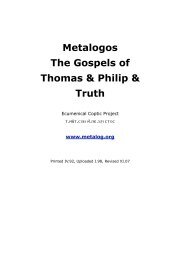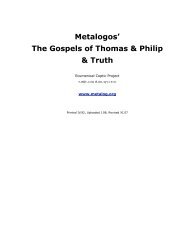Andrew Louth - Syriac Christian Church
Andrew Louth - Syriac Christian Church
Andrew Louth - Syriac Christian Church
You also want an ePaper? Increase the reach of your titles
YUMPU automatically turns print PDFs into web optimized ePapers that Google loves.
204 NOTES<br />
2 Discussed above, chapter 4 of the Introduction.<br />
3 See Jeauneau (1988), 10–11.<br />
4 From St Gregory Nazianzen’s Sermon 21.2, in praise of St Athanasius<br />
(PG 35.1084C).<br />
5 This introduces a borrowing from Nemesius, On human nature 12<br />
(Morani [1987], 68).<br />
6 This again introduces a borrowing from Nemesius, On human nature 41<br />
(Morani [1987], 117).<br />
7 On these three kinds of motion of the soul, cf. Denys the Areopagite,<br />
Divine Names IV.8–10 (704D–705C), who calls the three kinds of motion<br />
circular, in a straight line, and spiral. See Gersh (1978), 253, n. 229.<br />
8 ‘With reference to cause’: kat’ aitian. Proclus distinguishes between<br />
predication kat’ aitian, kath’ hyparxin (by existence or possession), and<br />
kata methexin (by participation): Elements of Theology 65 (Dodds [1963],<br />
62; see his commentary, ibid. 235–6). The distinction is also found in<br />
Denys the Areopagite: e.g., Ep. 9.2:1108D.<br />
9 Here, as elsewhere, philanthrôpic,<br />
10 Gnômê.<br />
11 Maximus’ mind has moved from the cloud that led the people of Israel in<br />
the wilderness to the crossing of the Red Sea dryshod (Exod. 14:15–29),<br />
perhaps because the pillar of cloud is first mentioned in this passage<br />
(see verse 19).<br />
12 See Exod. 14:15–29.<br />
13 See Exod. 19:16–20. Discussion of this passage has a long tradition: see<br />
Philo, Life of Moses II.70–166, Gregory of Nyssa, Life of Moses II.152–<br />
201, Denys the Areopagite, Mystical Theology I.3.<br />
14 For this absolute use of ‘was’ (Greek: ên), see the n. 101, below.<br />
15 Not included in Migne. Text taken from Sherwood (1955a), 41, who<br />
prints it from a MS in the Vatican Library. For the scriptural text<br />
discussed, see Exod. 12:34, 39.<br />
16 See Joshua 3:14–17.<br />
17 Called in English bibles ‘Joshua’. The LXX form ‘Jesus’ makes evident<br />
the typological relationship between the Old Testament leader of Israel,<br />
who succeeded Moses, and Christ, which Maximus develops in what<br />
follows. The two forms of the name are simply the Hebrew and Greek<br />
forms. In Greek Joshua is called ‘Jesus, son of Navê’ if there is danger of<br />
unclarity.<br />
18 Joshua 5:2–3.<br />
19 Israel: the name taken to mean ‘one who sees God’, a common<br />
interpretation: see Philo, On the Allegories of the Laws II.34, III.15, 172,<br />
186, 212 and frequently elsewhere.<br />
20 Joshua 6.<br />
21 In English bibles, Achan, son of Carmi.<br />
22 In English bibles, Hazor.<br />
23 One of the Origenist errors condemned in the sixth century was that the<br />
heavenly bodies had souls: Anathema 6 in Justinian’s Edict (Denzinger<br />
and Schönmetzer [1976], 406). See Scott (1991).




